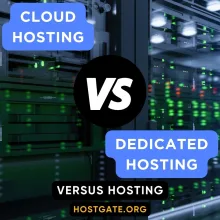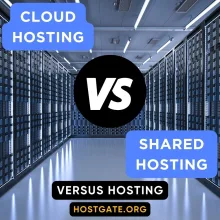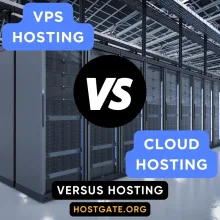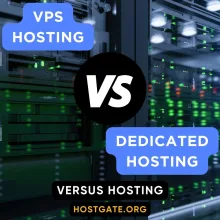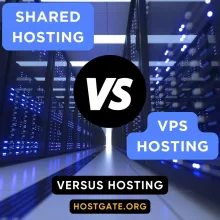Cloud Hosting vs Traditional Hosting – Which One is Better? | HostingVS
The comparison between cloud hosting and traditional hosting represents a crucial decision for businesses. Traditional hosting relies on physical servers in specific locations, requiring significant upfront investment and maintenance, while cloud hosting utilizes distributed virtual servers offering flexibility and scalability. The choice between these options depends on various factors including cost structure, resource management, security requirements, and environmental impact.
Traditional hosting provides complete control but demands higher operational overhead, whereas cloud hosting offers pay-as-you-go pricing and automatic maintenance but may have unpredictable costs. While cloud hosting dominates the market with providers like AWS, Google Cloud, and Microsoft Azure, traditional hosting remains relevant for specific use cases. Organizations must carefully evaluate their needs, considering factors such as growth projections, compliance requirements, and technical expertise when making this decision. Hybrid solutions are emerging as a popular middle ground, combining benefits of both approaches.

 Experience the Most Affordable and Reliable Cloud Web Hosting Cloud Web Hosting Starting at Just $3.99/month! - Unlimited Storage & Traffic - Free Domain Included - 24/7 Expert Support - Dedecated & VPS Hosting Plans |
Cloud Hosting VS Traditional Hosting | Cloud Hosting | Traditional Hosting |
Infrastructure & Architecture | Distributed network of virtual servers | Traditional Hosting:Single physical server or server cluster |
Scalability & Resource Management | Instant scalability | Physical hardware limitations |
Maintenance & Support | Provider-managed maintenance | In-house IT team required |
Security & Control | Provider-managed security | Complete control over security measures |
Cost Structure & Investment | Minimal upfront investment | High upfront hardware costs |
Cloud Hosting vs Traditional Hosting: A Comprehensive Comparison
The web hosting landscape has undergone a remarkable transformation since its inception. From basic shared hosting services, the industry has evolved into sophisticated cloud-based solutions dominated by tech giants like AWS, Google Cloud, and Microsoft Azure. The global web hosting market continues to expand, driven by increasing digital transformation and the growing need for scalable, reliable hosting solutions. This evolution has forced businesses to reevaluate their hosting strategies, with many moving away from traditional infrastructure toward more adaptable cloud-based solutions.
Understanding Infrastructure Differences
Traditional hosting operates on a straightforward principle: physical servers in specific locations handle all hosting needs. This approach requires significant upfront investment in hardware, maintenance, and technical expertise. In contrast, cloud hosting leverages a distributed network of virtual servers across multiple data centers, providing redundancy and flexibility through virtualization technology. While this distributed architecture offers numerous advantages, it can also introduce complexity in management and potential latency issues depending on data center locations.
Resource Management and Scalability Challenges
The fundamental difference in resource management capabilities stands as a crucial differentiator between these hosting types. Traditional hosting faces constraints due to physical hardware limitations, necessitating careful capacity planning and potential overprovisioning. When additional resources are needed, the process involves purchasing and installing physical hardware, leading to downtime and expenses. Cloud hosting, however, excels with instant scalability through virtual resource allocation. While this flexibility is advantageous, it can lead to over-provisioning and unexpected costs if not properly monitored.
Cost Implications and Economic Considerations
The financial aspects of hosting choices have become increasingly complex. Traditional hosting demands substantial upfront investments in hardware and ongoing maintenance costs, with fixed monthly or annual fees regardless of resource utilization. Cloud hosting’s pay-as-you-go model appears more attractive initially, charging only for resources consumed. However, organizations often face challenges with cost prediction and control, especially during peak usage periods. Hidden costs such as data transfer fees and storage expenses can accumulate quickly without proper oversight.
Performance Metrics and Reliability Factors
Performance variations between traditional and cloud hosting stem from their fundamental architectural differences. Traditional hosting provides consistent performance for predictable workloads but struggles with unexpected traffic spikes. Cloud hosting offers superior reliability through distributed architecture and automatic failover systems. However, performance can be affected by factors such as network latency, multi-tenant environments, and the “noisy neighbor” effect, where other customers’ usage impacts shared resources.
Security and Compliance Considerations
Security remains a critical concern, with both hosting types offering distinct advantages and challenges. Traditional hosting provides complete control over security measures but requires substantial in-house expertise. Cloud providers invest heavily in security infrastructure and regular updates, often exceeding individual organization capabilities. However, compliance requirements, particularly in heavily regulated industries, can complicate cloud adoption. Data sovereignty issues and specific industry regulations may necessitate hybrid solutions or traditional hosting approaches.
Maintenance and Support Requirements
The operational overhead between hosting types varies significantly. Traditional hosting demands dedicated IT staff for maintenance, updates, and troubleshooting, leading to higher operational costs. Cloud hosting providers handle most maintenance tasks automatically, reducing internal IT burden. However, this automation can lead to decreased control over maintenance windows and potential service interruptions. Organizations must carefully evaluate their need for control versus the convenience of managed services.
Environmental Impact and Sustainability
Environmental considerations have become increasingly crucial in hosting decisions. Traditional hosting often results in higher energy consumption due to inefficient resource utilization and constant power requirements. Cloud providers typically operate more energy-efficient data centers at scale, utilizing renewable energy sources and optimizing resource usage. However, the environmental impact of data center construction and the energy consumption of redundant systems should not be overlooked.
Migration Challenges and Considerations
The transition between hosting solutions requires careful planning and assessment. Organizations must evaluate current infrastructure, application dependencies, and business requirements. Migration challenges can include data transfer complications, application compatibility issues, and potential service interruptions. While cloud migration tools have improved significantly, the process still carries risks and requires comprehensive testing and rollback strategies.
Making the Right Choice
Choosing between traditional and cloud hosting requires a systematic evaluation of business needs, technical requirements, and financial considerations. Small businesses often benefit from cloud hosting’s flexibility and lower upfront costs, while enterprises with stable, predictable workloads might find traditional hosting more cost-effective. Organizations must consider factors such as growth projections, compliance requirements, budget constraints, and technical expertise when making this decision.
Future Outlook and Industry Trends
The hosting industry continues to evolve with emerging technologies like edge computing, serverless architecture, and improved containerization solutions. Hybrid solutions combining traditional and cloud hosting are gaining popularity, offering organizations the best of both worlds. The integration of AI and machine learning in hosting management tools is improving automation and optimization capabilities, though this technology also introduces new complexities and considerations.
Conclusion
The decision between cloud and traditional hosting remains highly dependent on individual organizational needs and circumstances. While cloud hosting offers superior flexibility and scalability, traditional hosting maintains advantages in certain scenarios, particularly regarding control and predictable workloads. Success lies in understanding each approach’s strengths and limitations, carefully considering business requirements, and potentially implementing hybrid solutions that leverage the best of both worlds. As technology continues to evolve, organizations must remain adaptable and ready to adjust their hosting strategies to meet changing business needs and technological advancements.
Summary and FAQs
What are the main cost differences between cloud hosting and traditional hosting?
Let me break down the key cost differences between cloud and traditional hosting, structured differently from the article:
Initial Investment:
- Traditional Hosting requires large upfront capital expenditure for hardware, infrastructure, and setup
- Cloud Hosting has minimal upfront costs, operating primarily on an operational expenditure model
Ongoing Expenses:
Traditional Hosting:
- Fixed monthly/annual fees regardless of usage
- Regular maintenance and hardware replacement costs
- Staff costs for dedicated IT personnel
- Power and cooling expenses for physical infrastructure
- Facility costs for housing servers
Cloud Hosting:
- Pay-as-you-go model based on actual resource consumption
- Variable costs that scale with usage
- Potential hidden costs like:
- Data transfer fees
- Storage costs
- Additional service fees for premium features
- Bandwidth charges
Cost Predictability:
- Traditional Hosting offers more predictable costs due to fixed payment structures
- Cloud Hosting can be less predictable, with costs fluctuating based on usage patterns and resource demands
Resource Utilization:
- Traditional Hosting often leads to over-provisioning to handle peak loads
- Cloud Hosting allows for more efficient resource utilization, but requires careful monitoring to prevent cost overruns
How does scalability compare between cloud and traditional hosting?
Let me break down the scalability comparison between cloud and traditional hosting:
Cloud Hosting Scalability:
- Immediate resource allocation through virtualization
- Automatic scaling up or down based on demand
- No physical hardware limitations
- Can handle unexpected traffic spikes efficiently
- Geographic expansion possible without new physical infrastructure
- Resources can be scaled within minutes
Traditional Hosting Scalability:
- Limited by physical hardware capacity
- Requires manual hardware procurement and installation
- Scaling process involves downtime
- Must plan ahead for growth
- Physical space constraints in data centers
- Scaling can take days or weeks to implement
Key Differences:
Time to Scale
- Cloud: Nearly instant deployment
- Traditional: Days or weeks for hardware procurement and setup
Flexibility
- Cloud: Can both increase and decrease resources as needed
- Traditional: Difficult to scale down once hardware is purchased
Cost of Scaling
- Cloud: Proportional to actual usage
- Traditional: Large upfront investments for anticipated future needs
Geographic Reach
- Cloud: Easy expansion to new regions through provider’s network
- Traditional: Requires new physical infrastructure in each location
Which hosting type offers better security and data protection?
Let me analyze the security and data protection aspects of both hosting types:
Traditional Hosting Security Features:
- Complete control over security infrastructure
- Direct physical access control to servers
- Customizable security protocols
- No shared infrastructure risks
- Private network configuration options
- In-house security team management
However: - Requires substantial internal security expertise
- Limited by organization’s security budget
- May lack latest security updates if not maintained
- Vulnerable to physical site disasters
Cloud Hosting Security Features:
- Enterprise-grade security infrastructure
- Regular automatic security updates
- Advanced threat detection systems
- Distributed architecture reducing single points of failure
- Multiple data center redundancy
- Professional security teams from cloud providers
However: - Shared infrastructure risks (“noisy neighbor” issues)
- Less direct control over security measures
- Data sovereignty challenges
- Potential compliance complications
The Better Choice Depends On:
Industry Requirements
- Highly regulated industries might need traditional hosting for compliance
- Standard business applications often secure enough with cloud hosting
Internal Capabilities
- Organizations with strong security teams might prefer traditional control
- Those without security expertise benefit from cloud providers’ security
Budget Considerations
- Cloud providers offer enterprise-level security at shared costs
- Traditional hosting requires significant security investment
Data Sensitivity
- Extremely sensitive data might require traditional hosting
- Standard business data usually well-protected in cloud environments
What factors should businesses consider when choosing between cloud and traditional hosting?
Let me break down the key factors businesses should evaluate when making this hosting decision:
Business Requirements:
Workload Characteristics
- Predictable vs variable traffic patterns
- Peak load requirements
- Processing and storage needs
- Application performance demands
Financial Considerations
- Available budget for upfront investment
- Cash flow preferences (CapEx vs OpEx)
- Long-term cost projections
- Return on investment expectations
Technical Requirements
- Application compatibility
- Integration needs
- Database requirements
- Development environment preferences
- Backup and disaster recovery needs
Operational Factors
- Internal IT expertise and resources
- Desired level of control
- Maintenance capabilities
- Support requirements
- Geographic distribution needs
Compliance and Security
- Industry regulations
- Data sovereignty requirements
- Security protocol needs
- Audit requirements
- Privacy considerations
Growth and Scalability
- Anticipated business growth
- Market expansion plans
- Seasonal fluctuations
- Time-to-market requirements
- Geographic expansion plans
Risk Management
- Acceptable downtime tolerance
- Data loss tolerance
- Vendor lock-in concerns
- Business continuity requirements
- Disaster recovery needs
Can businesses combine both cloud and traditional hosting solutions?
Yes, businesses can definitely combine both hosting types through what’s known as hybrid hosting solutions. Let me explain how this works:
Hybrid Hosting Approaches:
- Keep sensitive operations on traditional servers while running public-facing services in the cloud
- Use cloud for backup and disaster recovery of traditional infrastructure
- Leverage cloud for handling traffic spikes while maintaining core systems on-premises
- Run development environments in the cloud while keeping production on traditional servers
Benefits of Hybrid Solutions:
Flexibility
- Choose optimal hosting type for each workload
- Balance control and scalability needs
- Maintain compliance while gaining cloud benefits
- Gradual migration path to cloud
Cost Optimization
- Keep predictable workloads on cost-effective traditional hosting
- Use cloud for variable workloads
- Reduce capital expenses while maintaining control
- Optimize resource allocation across platforms
Risk Management
- Distribute risks across different infrastructures
- Maintain business continuity options
- Better disaster recovery capabilities
- Reduced vendor lock-in risk
Implementation Considerations:
- Need for robust integration between environments
- Additional complexity in management
- Requires expertise in both hosting types
- Need for unified monitoring and security
- Clear data governance policies

